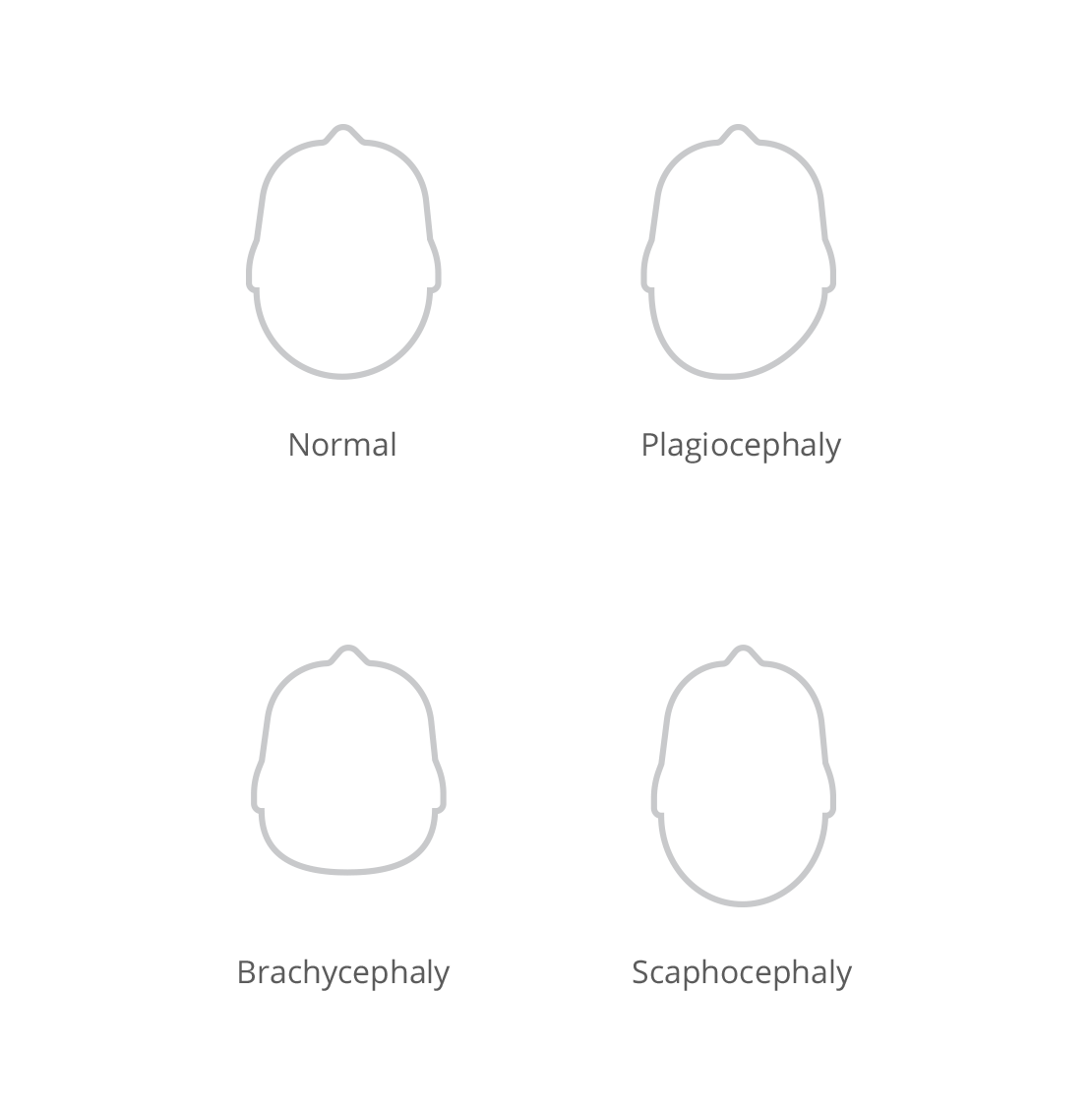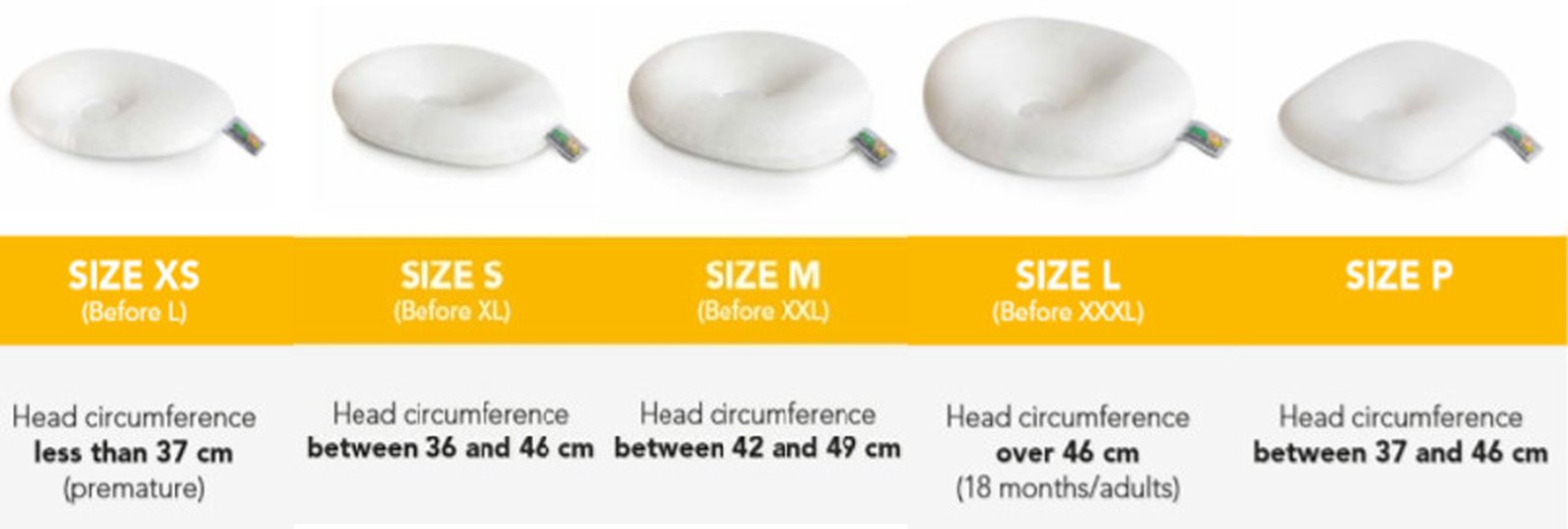Plagiocephaly
about flat head syndrome?
Here at Mimos, our experts have spent years designing and developing the perfect, safe pillow to prevent and reverse the impact of flat head syndrome. Below, you can find a whole host of FAQs, videos and downloadable resources that can help you to understand more about what exactly flat head syndrome is and how to combat its effects.
Resourceswhat is flat head syndrome?
Flat Head Syndrome is the flattening of one or both sides of the skull.
It most commonly occurs in the first 3 months of life, when the skull is still malleable and the head and brain are growing very quickly.
The term particularly describes a flattening to one side at the back of the head, but some facial asymmetry often results too.
In the moderate to severe cases, the following symptoms may also occur:
- Variations in the alignment of the eyes
- One eye appears larger than the other
- The ear on the affected side may be pushed further forwards the front of the head compared to the other side.
- One cheek appears fuller than the other.
- The forehead on the affected side becomes more prominent.
The most common form of this syndrome is called Plagiocephaly, but there are several types as shown.

 If you feel that your baby already has a flat spot, you should seek a formal diagnosis from a fully qualified paediatrician as soon as possible.
If you feel that your baby already has a flat spot, you should seek a formal diagnosis from a fully qualified paediatrician as soon as possible.

A constant pressure on a surface will create a flat spot
what are the causes?
Back-Sleeping Pressure
The positioning of the baby’s head is one of the main reasons for the appearance of these deformities, if a baby’s head stays in the same position for long periods of time, with specific areas lying against a flat surface, then those parts of his skull may become flattened.
With the recommendation that babies should sleep on their backs to prevent Sudden Infant Death Syndrome (SIDS or ‘cot death’), Plagiocephaly has increased dramatically due to the constant pressure that this sleeping position produces on the rear of the skull.
Infant Seating
It has been noticed that extensive use of car seats, infant swings and bouncy seats also contributes to Plagiocephaly. With extended use of these devices, the back of the head is placed against a rigid, unyielding surface. The resulting deformity can be severe, even causing “cornering” or “squaring” of the head.
Prematurity
The skull of the premature infant is softer than a full term born baby and they are more prone to positional plagiocephaly since they spend most of the time on their backs without being moved or picked up, due to their medical needs and extreme fragility after birth.
Sometimes new-born babies are unable to turn their head in one direction due to neck pain, resulting in a preferred head position placing constant pressure on one part of the skull.
Plagiocephaly can also found at birth as the result of a restrictive intrauterine environment, this effect is particularly prevalent in premature babies.
Congenital Muscular Torticollis (Wryneck)
This condition, which often develops in the first 2-4 weeks after birth, is where neck muscles develop a tightness, causing the head to tilt and/or turn, this tightness can cause the head to be held in a single position, which can result in Plagiocephaly.
Multiple Births
A crowded womb can also limit the movement of babies, resulting in pressure on the skull.
what are the risks?
It Might be a Serious Problem
In the past, parents have been advised that Flat Head Syndrome was purely a cosmetic concern which would fix itself. In more recent years, however, clinical studies have been done to investigate what longer term effects might be associated with a diagnosis of head flattening and/or torticollis.
While more comprehensive studies are still ongoing, recent research suggests that infants with plagiocephaly and/or torticollis may have other associated problems such as:
A high risk for learning delays and developmental delay
Increased need for special services when the child reaches school age
Orthodontic and TMJ issues
Scoliosis
Visual disturbances including visual field defects, and astigmatism
Auditory problems

preventing flat head syndrome
Although there are many conditions and situations that give rise to Flat Head Syndrome, the main cause is pressure applied to the skull. We recommend several strategies for reducing the presence of pressure and minimising the chances of your baby developing Flat Head Syndrome.
tummy time
Tummy time is an excellent physical activity for a newborn, in addition to keeping pressure off their skull it helps to develop many muscles and motor skills, but it must always be done when your baby is awake and it is important that you are always with your baby for the full duration of this time.

Tummy time is ideally introduced within the first few days of life and continued thereafter. Below are some tips to get you started:
Start Early
Placing your newborn belly-down on your chest, or across your lap, for a few minutes is a good start to get them accustomed to the position.
Think comfort
Lay your little one down on a flat, clean surface, such as a blanket or play mat on the floor. If they squirm or cry try some extra padding. Roll up a small receiving blanket and tuck it under their chest at the nipple level, with arms forward of the roll, to help shift the weight posteriorly. This small adjustment can make big a difference for your baby's tolerance of tummy time.
Add a little extra time
Put baby on their tummy after each nappy change. Add a little extra time each day. Short periods of quality tummy time are more beneficial than leaving baby in a prone position for a longer time while crying.
Go head to head
Lie down on the floor and get face-to-face with your infant. Make goofy noises and expressions, or sing songs. You might feel silly, but your infant will be less likely to fight being on their belly.
Provide Distractions
Hold a mirror in front of your baby to capture their attention, or place brightly coloured stuffed animals just within her reach. There are also plenty of tummy-time toys that can keep your baby from getting bored.
Involve Others
Encourage friends, relatives, and your child's caregivers to get down on the floor for short periods of tummy time with them as well.
sleeping position
Your baby will spend a lot of time sleeping and it is important that they are always placed to sleep on their back to minimise the risk of SIDS. We recommend the use of Mimos Pillow to prevent a concentration of pressure on one part of the skull during sleeping, but there are other tips you can follow too.
To reduce pressure on any given point of the skull, you need to rotate the head positions when sleeping on the back to reduce and redistribute the pressure, these tricks might help you do this:
Put your baby at opposite ends of the cot each night to encourage them to face to both directions.
Place brightly-coloured cot-safe toys next to their cot to attract their attention and help them turn their head in a different direction each night.
If your baby prefers to fall asleep while facing you, then change your position each night so that their head does not rest on the same side.
Handling Baby Differently
Another way to take pressure off the back of the baby’s head is to carry your baby, you could place your baby on your arm facing down, or on your shoulder, or on your hip, or use a sling, or a front baby carrier.
It is good to alternate the way in which you approach and handle your baby, so that they are in the habit of rotating their neck both ways.
Mimos baby pillow
Mimos Pillow is clinically proven to be effective in preventing Flat Head Syndrome. Its unique breath-through material makes it very safe to use and we have had it extensively tested and certified. To be effective, it is important that the correct size of pillow is used, this will mean getting larger pillows as your baby grows until they are old enough for their skull to be safe from deformities.


